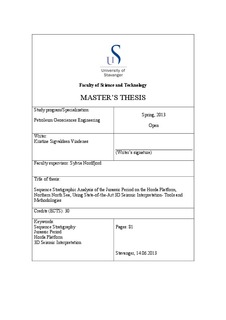| dc.contributor.author | Vindenes, Kristine Sigvaldsen | |
| dc.date.accessioned | 2013-11-14T12:37:50Z | |
| dc.date.available | 2013-11-14T12:37:50Z | |
| dc.date.issued | 2013-06-16 | |
| dc.identifier.uri | http://hdl.handle.net/11250/183565 | |
| dc.description | Master's thesis in Petroleum geosciences engineering | no_NO |
| dc.description.abstract | A sequence stratigraphic analysis of the Jurassic sequence on the Horda Platform is the main focus for this study. The analyzed interval comprises the stratigraphic record from three mega-sequences; the Base Cretaceous Unconformity to top Brent Group (Upper Jurassic), Brent Group (Middle Jurassic) to top of Statfjord Formation (Lower Jurassic), and Statfjord Formation to top Triassic. These mega-sequences were used as a steering framework for a tracked HorizonCube (HC) that is generated based on a SteeringCube. The HC generates a dense set of automated horizons tracked in a dip-field, which is used to create a WheelerCube. The WheelerCube can be used to interpret systems tracts and their respective bounding surfaces with distance versus relative geologic time.
The main objective of this thesis is to determine whether the results generated from these new sequence stratigraphic tools- and methodologies used in OpendTect (dGB Earth Sciences) will improve the sequence stratigraphic interpretation of seismic data, and if they are more time-efficient and user friendly.
WheelerCube interpretations based on 3D and 2D HC-tracking are compared with each other and with previous studies from the Jurassic sequence on the Horda Platform.
The results from this analysis show that the WheelerCube generated from the 3D HorizonCube-tracking displays a low resolution and inaccurate outcome. This result leads to a different systems tracts interpretation than the WheelerCube from 2D HC-tracking. The different results depend on the HC-tracking, which is poor and time-consuming in 3D whereas good and time-efficient in 2D.
As a consequence of the poor HC-tracking in 3D, the WheelerCube does not improve the sequence stratigraphic interpretation compared to previous studies from the same area.
Suggestions for improvement of the sequence stratigraphic interpretation are creating a 2D grid of the WheelerCubes generated from 2D–tracking, as well as generating a smaller 3D cube that is less constrained by faults. Unfortunately, there was no time to perform these suggestions during the remainder of this thesis. | no_NO |
| dc.language.iso | eng | no_NO |
| dc.publisher | University of Stavanger, Norway | no_NO |
| dc.relation.ispartofseries | Masteroppgave/UIS-TN-IPT/2013; | |
| dc.subject | petroleumsteknologi | no_NO |
| dc.subject | petroleumsgeologi | no_NO |
| dc.subject | stratigraphy | no_NO |
| dc.subject | Jurassic | no_NO |
| dc.subject | Horda platform | no_NO |
| dc.subject | 3D seismic interpretation | no_NO |
| dc.title | Sequence stratigraphic analysis of the Jurassic period on the Horda Platform, northern North Sea, using state-of-the-art 3D seismic interpretation- tools and methodologies | no_NO |
| dc.type | Master thesis | no_NO |
| dc.subject.nsi | VDP::Technology: 500::Rock and petroleum disciplines: 510::Geological engineering: 513 | no_NO |
